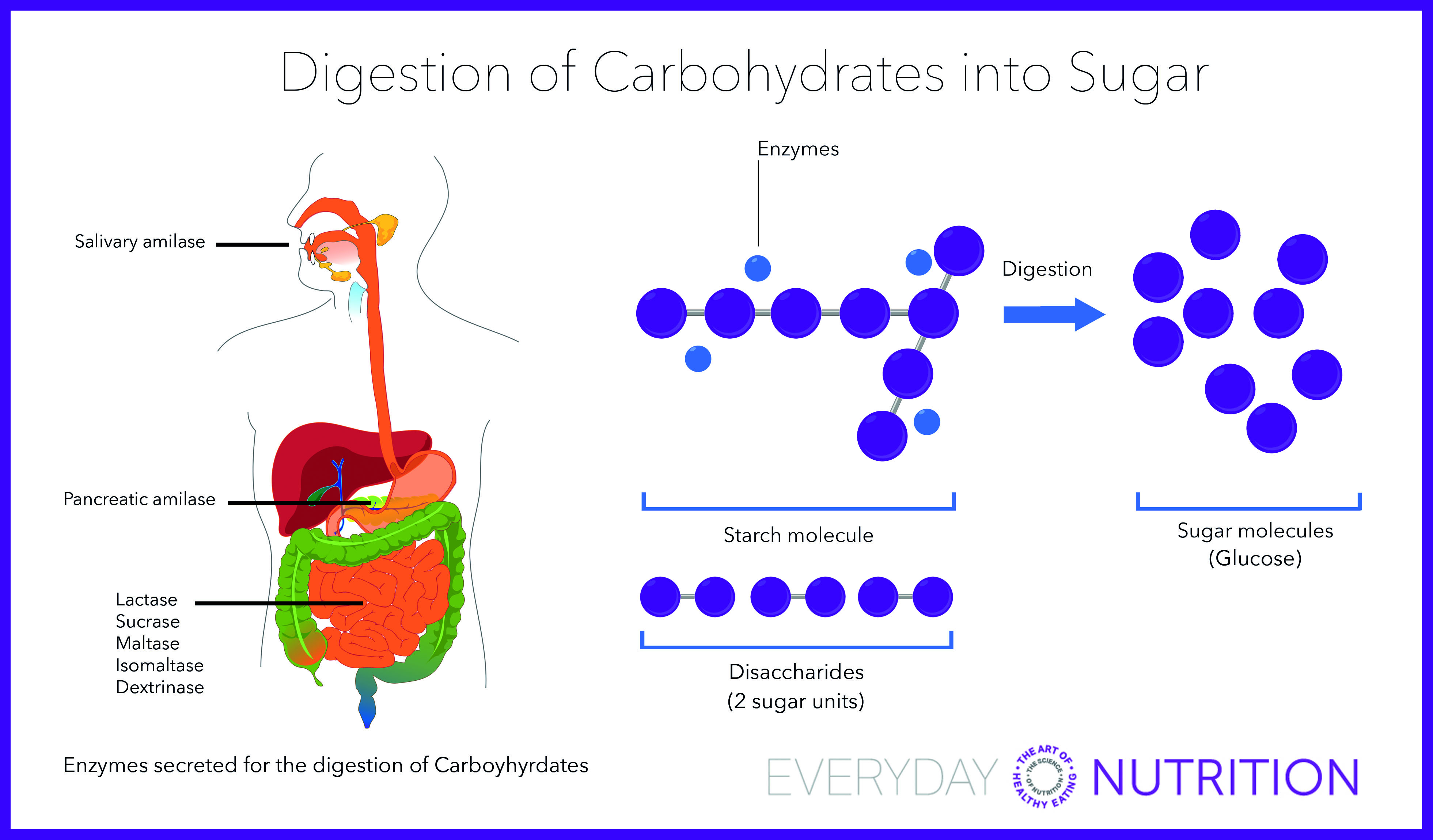All 37 trillion cells of your body need sugar to produce energy and perform their metabolic functions to keep you alive and happy! You have approximately 5 l. of blood circulating in your body at any given time and all you need to feel great and be able to perform all your normal activities is approximately 1 teaspoon of sugar…just one!
(Currently in the UK the average person gets around 16-17 per cent of their daily calories from sugar, which translates into circa 80g of sugar or about 20 teaspoons!)
You eat carbs rich foods, you break them down into glucose, glucose is released into the blood stream, and the level of blood glucose increases and stimulates the pancreas to release insulin. Insulin travels into the blood and allows the cells of your body to uptake glucose to be used as energy.
But let’s see how this happens in more detail (or if you rather skip to the next part 😉 )
Food to glucose and glucose to energy

The type of sugar metabolized for energy, is glucose, which is found, directly or indirectly in any carbohydrate containing foods that we eat. Carbohydrate rich foods such as fruits, grains, pulses, vegetables, and products such as pasta, breads, cakes, sweets, biscuits etc. all contain a variety of different kind of sugars.
These different types of sugars are broken down into glucose, through various digestive processes in your stomach and intestinal tract and through other processes in your liver. (Other types of macronutrients such as protein and fats can also be broken down for energy but in different and more complicated ways than carbohydrates).
Glucose is then released into the blood stream to be distributed to every single cell of your body. Glucose (being a water-soluble molecule cannot diffuse through the cell membrane which is made of a lipid bilayer) enters the cell using transport channels, called GLUT. These are like doors, which appear on the surface of the cell membrane to allow glucose to enter the cell.
The glucose doors on the cells of muscles, including the heart, and fat tissue, are called GLUT4. These “doors” are not always present on the cell membrane but only appear when insulin binds to specific cell membrane receptors (imagine these looking like little protruding arms on the cell surface).
Insulin, a hormone produced by the pancreas, is therefore of vital importance because it allows glucose to enter the cells of your body. Without insulin you wouldn’t be able to produce energy and survive!
The pancreas secretes insulin when it is necessary and this is when there is an elevated amount of sugar in your blood stream (above the normal level of 3.9 to 5.5 mmols/l).
It is a very efficient and smart system isn’t it? The problems start if you continually over load your blood with excessive amounts of sugars! Let me explain why.
What happens when your blood sugar level is too high?
As I said, all you need to feel great and be able to perform all your normal activities is approximately 1 teaspoon of sugar circulating in your blood vessels.
Let me put this into context … just looking at breakfast …1 small pot of fruit yogurt contains about 3-4 teaspoon of sugar, one granola bar can have as much as 2 teaspoons per bar, a glass of orange juice 4 teaspoons … so although these choices might seems like healthy options, you have already totaled up to 10 teaspoons of sugar even before you start your day! So your blood sugar rises, insulin comes to work and the excess sugar gets distributed into your cells.
But what happens to the excess glucose that is not needed for energy production?
Some of the glucose surplus is converted into glycogen (a form of glucose storage in the liver and in the muscles which is needed to keep blood sugar balanced); the rest is taken up by your fat cells under the skin (subcutaneous fat) and around our organs (visceral fat).
And guess what happens? The glucose is converted into glycerol, which will be used to form triglycerides or simply put: fat!
So excess glucose = fat formation and deposition.
When your blood sugar is low the hormone glucagon is released from the pancreas and the hormone adrenalin is released from our adrenal glands (tiny glands situated on the top of your kidneys). Both these hormones stimulate the liver to break down some deposit of glucose (glycogen) to quickly release some glucose into the blood stream. Please note: glycogen not fat!
The release of adrenalin, the hormone secreted in response to stress, is part of our evolutionary survival mechanism; the consequent release of glucose would have helped our ancestors to prepare for gathering and hunting for foods, not quite what happens nowadays…more like food is gathering us and any release of adrenalin in response to any stress contributes to weight gain.
When your blood sugar level is too low, the body craves sugar and stimulants and you feel stressed. Feeling of tiredness, lethargy, poor concentration, low moods and irritability appear and these encourage you to seek out for stimulants such as coffee, teas, fizzy drinks, alcohol, cigarette and high-refined carbohydrates foods (biscuits, cakes, bread, pizza…) for a quick sugar and energy fix.
So when you get into a low glycemic state your food choices are driven by a very strong physiological need for glucose and have very little to do with discipline, self-control and will power!
What happens in the long term when your blood sugar levels are imbalanced?
So far, I have explained how imbalanced blood sugar control leads to weight gain, low moods, difficulty at concentrating, irritability, cravings and poor food choices but having high blood sugar levels and consequently high and frequent release of insulin lead to more serious health consequences such as:
- Insulin resistance, when the cell receptors becomes less sensitive to insulin and therefore glucose builds up in the blood instead of being absorbed by the cells
- Insulin resistance, if untreated, leads to diabetes type II.
- The brain becomes insulin resistant along with the rest of the body, and the area most responsible for appetite control, the hypothalamus loses the ability to switch the “off” button for appetite and you will never feel your hunger satisfied.
- Increased blood pressure.
- Oxidative stress to the lining of the blood vessels and increased production of pro-inflammatory molecules, which contributes to the development of cardio vascular diseases.
- A decrease in HDL (the healthier type of cholesterol), an increase in LDL (the detrimental type of cholesterol) and an increase in triglycerides (a type of fat) all of which increase your risk for heart disease.
- Hormonal imbalances due to decreased SHBG (sex hormone binding globulin)
- Formation of Advanced Glycation End Products (AGEs), proteins or fats that become “glycated” (sugar coated) after exposure to sugars. Our body recognizes AGEs as toxins and responds with low-level generalized inflammation that if prolonged will slowly damage every organ in the body. Most chronic diseases are associated with inflammation and high levels of AGEs. AGEs also can cause proteins to stick together. With years, AGE-proteins become rigid. This is one reason why joints, muscles and tendons become stiff and inflexible over time and skin ages prematurely.
- A higher risk for cancer due to insulin’s ability to contribute to cell proliferation and increased systemic inflammation.
How do you balance blood sugar levels?
The way to balance your blood sugar levels is by following a low GL (glycemic index) eating style, a delicious and practical eating style that I teach to my clients as the first and essential part of any of my programs.
Watch out for my next post where I will be explaining what is the Glycemic Load of a food and the difference between GI (Glycemic Index) and GL. I will also give you plenty of practical and tested tips on how to start balancing your blood sugar levels naturally and practically.
Wishing you optimal health,
Monica x






0 Comments